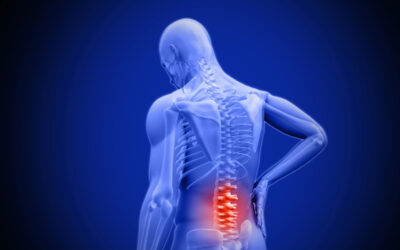
If you’re one of the 80% of adults who will experience low back pain at some point in their lives, it’s important to understand the differences between acute and chronic low back pain. While both can be debilitating, acute back pain often resolves on its own within weeks, while chronic back pain is more complex and long-lasting. Knowing when to seek medical attention and how to manage your symptoms effectively can help minimize disruptions to your daily life. In this guide, we’ll explore the characteristics, causes, and treatments for both acute and chronic low back pain so you can work with your doctor on the right plan for you.
What is Acute Low Back Pain?
Acute low back pain comes on suddenly and severely, though typically lasts just a few days or weeks. It’s often caused by injuries like muscle strains, sprains, or fractures. Activities that require forceful twisting motions like heavy lifting or contact sports can also bring on acute back pain. The pain is usually localized to a specific area, often accompanied by muscle spasms and stiffness. Sitting, standing, or moving may aggravate your symptoms.
Acute low back pain can range from mild to completely debilitating. In most cases, symptoms start to improve within 4 to 6 weeks as the underlying injury heals. However, for some, acute back pain can linger for months. It’s important to consult your doctor if your pain persists beyond a few weeks or severely limits your mobility.
Diagnosing Acute Low Back Pain
To diagnose the cause of acute low back pain, your doctor will ask about your symptoms, medical history, and perform a physical exam. They may check your reflexes or conduct tests to determine the exact location of pain.
If the cause isn’t clear, your doctor may order imaging tests like X-rays, CT scans or MRIs. These can reveal issues like fractures, disc damage, arthritis, or nerve compression. Rarely, blood tests may be needed to check for underlying infections or other serious conditions.
Treating Acute Low Back Pain
The main goals for treating acute low back pain are pain management, restoring mobility, and preventing complications. Your doctor may recommend:
- Rest: Avoid strenuous activity for the first few days to allow your back to heal. Apply ice packs to ease pain and inflammation.
- Medications: Over-the-counter pain relievers like NSAIDs (ibuprofen, naproxen) or acetaminophen can help relieve pain. Your doctor may prescribe muscle relaxers.
- Physical Therapy: Specific exercises can stretch tight muscles, improve core strength, and restore range of motion. Your PT can design a program tailored to your condition.
- Epidural Steroid Injections: For severe pain that doesn’t respond to other treatments, an injection of corticosteroids into the epidural space around your spinal nerves can help reduce inflammation.
With proper rest and care, acute low back pain often resolves within a few weeks without the need for extensive treatment. But if your pain persists or worsens, be sure to follow up with your doctor.
What Is Chronic Low Back Pain?
Chronic low back pain persists for 12 weeks or longer. Unlike acute pain, chronic back pain may linger even after an initial injury has healed. In many cases, the exact cause is difficult to pinpoint. Factors like poor posture, obesity, arthritis, aging, and repetitive motions can all contribute to chronic back pain. The pain is often described as dull, stiff, and achy, present most days. It may come and go in severity.
Chronic back pain can greatly impact quality of life, limiting mobility and the ability to perform daily activities. Finding an effective management strategy usually requires some trial and error. Since the pain is unlikely to completely resolve, treatment focuses on improving function and helping patients cope with symptoms.
Diagnosing Chronic Low Back Pain
A thorough medical evaluation is needed to diagnose chronic low back pain. Your doctor will perform a physical exam, order imaging tests, and review your full medical history. MRI and X-ray results can reveal issues like disc degeneration, spinal stenosis (narrowing), or spondylolisthesis (misalignment). Blood tests may check for autoimmune disorders. Your doctor will try to pinpoint factors contributing to your ongoing pain.
Treating Chronic Low Back Pain
A multi-pronged approach is often needed to manage chronic back pain:
- Medications: NSAIDs, acetaminophen, topical agents, antidepressants, and anticonvulsants may be used for pain relief. Opioid pain medications are controversial but sometimes prescribed on a short-term basis.
- Exercise: Specific stretches and low-impact aerobic exercise can improve flexibility and function. Walking, swimming, and yoga are great options.
- Physical Therapy: Hands-on techniques like massage, ultrasound, and electrical stimulation can help relax muscles. Your PT can show you proper lifting mechanics.
- Injections: Trigger point injections, facet joint injections, and epidural steroid injections can relieve localized back pain.
- Lifestyle Changes: Smoking cessation, weight loss, ergonomic adjustments at work, stress management, and sufficient sleep and rest can all help reduce flare ups.
- Surgery: For severe chronic pain caused by specific structural problems like spinal stenosis or slipped discs, procedures like discectomies, laminectomies, or spinal fusions may provide relief when more conservative approaches fail.
Working closely with your doctor to find the right combination of treatments tailored to your condition offers the best chance at managing chronic back pain and improving your quality of life.
Key Differences Between Acute and Chronic Low Back Pain
While both can greatly impact your life, remembering these key differences can help you better understand and manage your specific pain:
- Onset: Acute pain starts suddenly; chronic pain develops gradually over time
- Duration: Acute pain is short-term; chronic pain persists for months or years
- Severity: Acute pain can be severe but fluctuates; chronic pain is often milder but constant
- Cause: Acute pain usually arises from injury or overuse; chronic pain often has multi-factorial causes like arthritis or nerve damage.
- Diagnosis: Both involve imaging and physical exams, but chronic pain requires more extensive testing.
- Treatment: Acute pain is treated conservatively with rest, medication, and PT; chronic pain often requires a combination approach targeting pain mechanisms.
- Prognosis: Acute pain generally improves in several weeks; chronic pain requires long-term management.
When to Seek Medical Care
It’s important to seek prompt medical care for low back pain that:
- Is severe, unrelenting, or worsening
- Spreads down your leg (sciatica)
- Is accompanied by numbness, tingling, or leg weakness
- Follows a major trauma like a car accident
- Occurs with other concerning symptoms like fever, unexpected weight loss, or bowel/bladder changes
These can indicate serious underlying conditions requiring emergency care like fractures, infections, cauda equina syndrome, or cancer.
For chronic low back pain, see a specialist like an orthopedic spine surgeon or neurologist for a thorough evaluation. They can assess if options like surgery or pain management injections may help in your case. A physiatrist can oversee a whole-body rehab program.
Don’t hesitate to ask for referrals or second opinions to ensure you get the most effective care. Preventing acute flare ups and stopping chronic back pain from worsening is key. With the right treatment plan tailored to your needs, you can keep your back pain from spiraling out of control.
Conclusion
Whether acute or chronic, low back pain can severely impact your mobility and quality of life. Understanding the typical causes, symptoms, diagnosis, and treatment approaches for each type empowers you to make informed decisions. Catching acute back pain early and taking prompt rest and rehab steps may help prevent it from becoming a chronic problem. Managing chronic back pain requires patience, lifestyle changes, and a multi-modal treatment approach. By working closely with your doctor and spine specialists, you can find the right combination of therapies to relieve your specific back pain and get you moving comfortably again.
Written by Dr. Tony Mork
Orthopedic Spine Surgeon
I’m Dr. Tony Mork, MD, a Minimally Invasive Orthopedic Spine Surgery Specialist in Newport Beach, California. With over 40 years of experience, I’m dedicated to providing information for all topics that involve neck and back pain.
November 8, 2023
Contact a Spine Specialist Near You!
Related Articles
Lower Back Pain | An Overview
Lower back pain is an exceedingly common affliction that affects up to 80% of adults at some point in their lives. Understanding the underlying causes of lower back pain is key to finding the appropriate treatment and relief. Anatomy of the Lower Back The lower back,...
Degenerative Disc Disease | Causes and Risk Factors
Degenerative disc disease describes age-related wear and tear to the rubbery spinal discs cushioning the vertebrae that can lead to chronic back or neck pain. While partly genetic, there are also lifestyle factors and injuries that accelerate disc degeneration over...
Upper (Thoracic) Back Pain | What is Causing My Pain?
Upper back pain is a surprisingly common affliction, affecting up to one-quarter of the adult population at some point. While not as prevalent as lower back pain, discomfort in the thoracic region still accounts for a substantial slice of musculoskeletal complaints...



